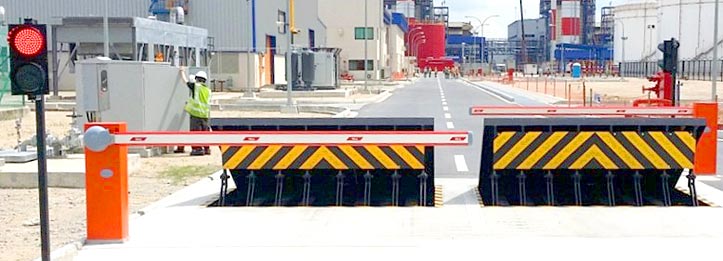Not known Incorrect Statements About Wedge Barriers
Wiki Article
Wedge Barriers for Dummies
Table of ContentsSome Known Facts About Wedge Barriers.The Of Wedge Barriers

Not known Facts About Wedge Barriers
The remaining pressure used to the cam to deploy the wedge plate 16 may might provided offered an electromechanical actuator 84 or other various other. The springtime assembly 54 and the actuator 84(e. Wedge Barriers. g., electromechanical actuator)might operate with each other to equate the cam and lift the wedge plate 16.
As pointed out over, the spring setting up 54 puts in a consistent force on the web cam, while the electromechanical actuator may be regulated to apply a variable pressure on the webcam, thereby allowing the lifting and decreasing( i. e., deploying and pulling back )of the wedge plate 16. In certain personifications, the constant pressure applied by the springtime assembly 54 might be adjustable. g., electromechanical actuator) is handicapped. As will be valued, the spring assembly 54 may be covered and shielded from particles or various other elements by a cover plate(e. g., cover plate 68 revealed in FIG. 4) that may be considerably flush with the elevated surface 38 of the structure 14. As discussed over, in the released setting, the wedge plate 16 offers to obstruct access or traveling past the barrier 10. For instance, the obstacle 10(e. g., the wedge plate 16 )might obstruct pedestrians or vehicles from accessing a property or pathway. As talked about above, the barrier 10 is connected to the support 30 safeguarded within the structure 14,

front braces 71. Therefore, the link settings up 72 might pivot and rotate to allow the collapse and expansion of the linkage assemblies 72 during retraction and deployment of the bather 10. The link settings up 72 reason activity of the wedge plate 16 to be restricted. If an automobile is taking a trip in the direction of the released wedge plate 16(e. For instance, in one situation, the security legs 86 may be prolonged duringmaintenance of the barrier 10. When visit homepage the safety legs 86 are released, the safety legs 86 sustain the weight of the wedge plate 16 versus the surface area 12. As an outcome, the lifting mechanism 50 may be shut off, serviced, removed, changed, and so forth. FIG. 5 is partial perspective view of an embodiment of the surface-mounted wedge-style barrier 10, showing the cam next page 80 and the cam surfaces 82 of the training device 50. Especially, 2 webcam surface areas 82, which are referred to as reduced web cam surface areas 83, are placed listed below the camera 80. The reduced cam surfaces 83 might be dealt with to the surface area 12 (e. For instance, the reduced webcam surface areas 83 and the installing plate 85 may create a single item that is secured to the anchor 30 by bolts or other mechanical fasteners. In addition, two cam surface areas 82, which are referred to as top camera surfaces 87, are positioned over the camera 80 and coupled to (e. In various other personifications, stepping in layers or plates may be placed in between the surface 12 and the lower cam surface areas 83 and/or the wedge plate 16 and the upper cam surface areas 87 content As stated over, the webcam 80 equates along the web cam surface areas 82 when the wedge plate 16 is raised from the retracted placement to the released setting. Furthermore, as mentioned above, the spring assembly 54 (see FIG. 3 )might provide a pressure acting upon the web cam 80 in the instructions 102 via spring pole 58, which might lower the force the electromechanical actuator 84 is required to use to the webcam 80 in order to actuate and raise the wedge plate 16. 1 )to the deployed setting(see FIG. 4). As shown, the camera 80 includes track wheels 104(e. g., rollers), which get in touch with and translate along the camera surface areas 82 throughout operation.
Report this wiki page